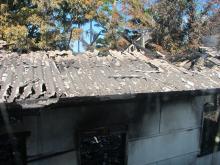- Home
- General information
- Fires
Asbestos
Fires
Information for home renovators, businesses and volunteers who are involved with a clean up and recovery of buildings damaged by fires.
Asbestos products are likely to be found in domestic and commercial buildings constructed or renovated before 1990. Typical asbestos containing materials found in these older properties include bonded (non-friable) products such as floor tiles, flat fibre cement sheeting (fibro) used in walls and ceilings, and corrugated roofing.
Impact of fire on asbestos containing materials
Asbestos containing materials can crack or spall from the heat generated by fire. Spalling occurs when flakes of the material 'pop' off due to the heat causing a build up of pressure inside the material. Asbestos fibres are released into the air during spalling.
Fires affecting properties made of asbestos containing materials can produce a range of asbestos debris, including unburnt and partly burnt pieces. The high heat generated by the fire can severely damage asbestos containing building materials and spread them some distance from the affected area.
Cleaning up after a fire
Unless the fire debris is significantly disturbed, the risk of exposure to airborne asbestos fibres to the public and neighbours is low. Monitoring of air during and after fires show that asbestos fibre concentrations typically are very low after a fire. This is likely to be due to the low numbers of fibres actually released and the large volumes of air circulated by fires.
More significant disturbances, such as during clean-up or demolition of the fire-damaged building, must be done safely to ensure the level of asbestos fibres in the air is kept very low.
To minimise airborne asbestos fibres, the following precautions should be taken:
- perform a careful assessment of the location of fire damaged asbestos containing materials
- restrict people, animals and machinery from affected areas. Warning signage should be used.
- keep debris wet until it can be cleaned up by a licensed asbestos removalist – but do not use water under pressure.
If you are just visiting a property but not cleaning up, to minimise exposure to airborne dust and other hazards from fire-damaged homes, wear protective clothing, including:
- sturdy footwear and heavy-duty work gloves
- disposable coveralls (with long sleeves and trousers)
- P2 face masks.
Further information on managing the risks from fire damaged asbestos containing materials can be found in the Containment and disposal of asbestos contaminated dust and debris arising from fire damaged buildings guidance document (PDF, 191 KB).

Related links
- Home
- General information
- What is asbestos?
- How was asbestos used?
- Are there health effects?
- The risks of exposure
- Health monitoring
- Legislation and codes of practice
- Low density asbestos fibre board
- Asbestos contaminated dust or debris
- Fires
- Cleaning up after floods and storms
- Importation prohibited
- Government and agency roles
- Asbestos in government assets
- Know where asbestos is
- Removing or disturbing asbestos
- Practical guidance
- Resources
- Asbestos alerts
- Asbestos news
- Codes of practice
- Guidance
- Films
- Asbestos safety session 2021
- Asbestos safety session 2020
- Cleaning Asbestos Roofs
- Shadow vacuuming with a H-Class vacuum cleaner
- Use and maintenance of a H-Class vacuum cleaner
- Identifying low density asbestos fibre board hazards and risks
- Working safely with asbestos for the home renovator
- How to properly wear personal protective equipment for airborne contaminants
- Personal protective equipment
- Dear Dad - An asbestos awareness film
- Clear and present danger: Asbestos exposed
- Uses and applications of asbestos - an extract from a film by Parsons Brinckerhoff
- Asbestos health issues - an extract from a film by Parsons Brinckerhoff
- Safe work procedure - storm and wind damage cleanup
- Drilling into asbestos walls and ceilings
- Asbestos - Removing switchboard panels
- Decontamination procedure, personal decontamination and cleanup procedures
- Asbestos awareness
- Safe work procedures
- Preparation before commencing the task
- Preparing and painting corrugated asbestos cement roof and fences
- Drilling into non-friable asbestos using a thickened substance to control airborne fibres and dust
- Drilling into non-friable ACM using an H rated industrial HEPA filter vacuum to control airborne fibres and dust
- Removing a small package electrical switchboard
- Cleanup and disposal
- Safe cleanup of storm damaged materials that may contain asbestos
- Frequently asked questions for homeowners and the general public
- Podcasts
- Strategies
- Working Safely with Asbestos Guide
- Asbestos awareness week 2025
- Asbestos management compliance campaign
- Induction and safety training for unlicensed work
- Sanctions